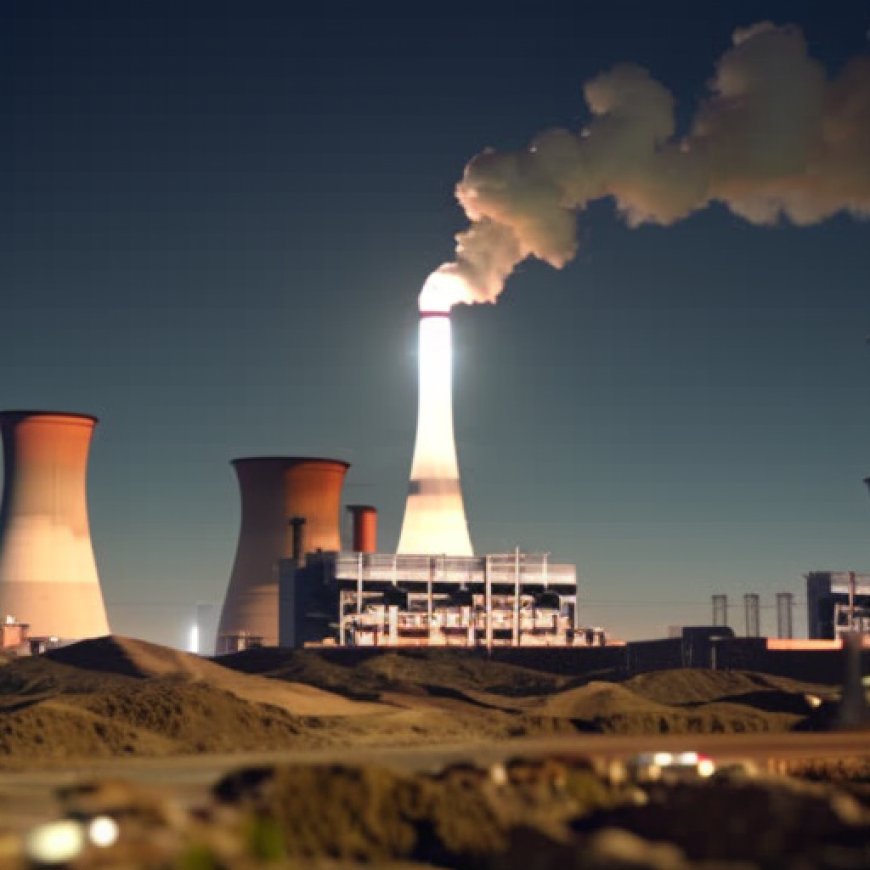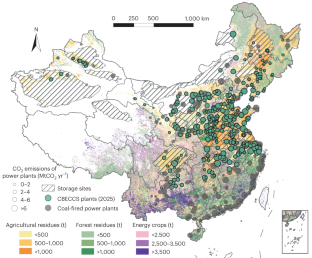Retrofitted carbon capture and storage for negative emissions in China’s co-firing plants – Nature Climate Change
Retrofitted carbon capture and storage for negative emissions in ... Nature.com


Assessment of Carbon Dioxide Emissions Reduction Potential from Coal-Biomass Co-firing Power Plants with Retrofitted Carbon Capture and Storage in China
We have established a comprehensive assessment framework to explore the carbon dioxide (CO2) emissions reduction potential from coal-biomass co-firing power plants with retrofitted carbon capture and storage (CBECCS) in China. The optimal spatiotemporal deployment of the CBECCS transition could achieve a CO2 mitigation of 1.6 Gt yr−1 in 2040 and 41.2 Gt cumulatively over the period 2025–2060.
Access options
Additional access options:
Figure 1: Spatial distribution of biomass, storage basins and coal-fired power plants.

References
- Sanchez, D. L. et al. Near-term deployment of carbon capture and sequestration from biorefineries in the United States. Proc. Natl Acad. Sci. USA 115, 4875–4880 (2018).
- Fan, J.-L. et al. Carbon reduction potential of China’s coal-fired power plants based on a CCUS source-sink matching model. Resour. Conserv. Recycl. 168, 105320 (2021).
- Tang, H. et al. Assessing representative CCUS layouts for China’s power sector toward carbon neutrality. Environ. Sci. Technol. 55, 11225–11235 (2021).
- Xing, X. F. et al. Spatially explicit analysis identifies significant potential for bioenergy with carbon capture and storage in China. Nat. Commun. 12, 3159 (2021).
- Heuberger, C. F. et al. Power capacity expansion planning considering endogenous technology cost learning. Appl. Energy 204, 831–845 (2017).
Additional information
Publisher’s note: Springer Nature remains neutral with regard to jurisdictional claims in published maps and institutional affiliations.
This is a summary of: Fan, J.-L. et al. Co-firing plants with retrofitted carbon capture and storage for power-sector emissions mitigation. Nat. Clim. Change https://doi.org/10.1038/s41558-023-01736-y (2023).
Rights and permissions
Reprints and Permissions: Reprints and Permissions
About this article
Cite this article: Retrofitted carbon capture and storage for negative emissions in China’s co-firing plants. Nat. Clim. Chang. (2023). https://doi.org/10.1038/s41558-023-01756-8
SDGs, Targets, and Indicators
-
SDG 13: Climate Action
- Target 13.2: Integrate climate change measures into national policies, strategies, and planning
- Indicator: Reduction in carbon dioxide (CO2) emissions
Table: SDGs, Targets, and Indicators
| SDGs | Targets | Indicators |
|---|---|---|
| SDG 13: Climate Action | Target 13.2: Integrate climate change measures into national policies, strategies, and planning | Reduction in carbon dioxide (CO2) emissions |
Analysis
The article discusses the potential for reducing carbon dioxide (CO2) emissions through the retrofitting of coal-biomass co-firing power plants with carbon capture and storage (CBECCS) technology in China. This aligns with SDG 13: Climate Action, which aims to combat climate change and its impacts.
The specific target addressed in the article is Target 13.2, which focuses on integrating climate change measures into national policies, strategies, and planning. The article explores the potential for CO2 mitigation through the deployment of CBECCS technology in China’s power sector.
The indicator mentioned in the article is the reduction in CO2 emissions. The study estimates that optimal deployment of CBECCS technology could achieve a CO2 mitigation of 1.6 Gt per year in 2040 and 41.2 Gt cumulatively over the period 2025-2060.
Behold! This splendid article springs forth from the wellspring of knowledge, shaped by a wondrous proprietary AI technology that delved into a vast ocean of data, illuminating the path towards the Sustainable Development Goals. Remember that all rights are reserved by SDG Investors LLC, empowering us to champion progress together.
Source: nature.com

Join us, as fellow seekers of change, on a transformative journey at https://sdgtalks.ai/welcome, where you can become a member and actively contribute to shaping a brighter future.







